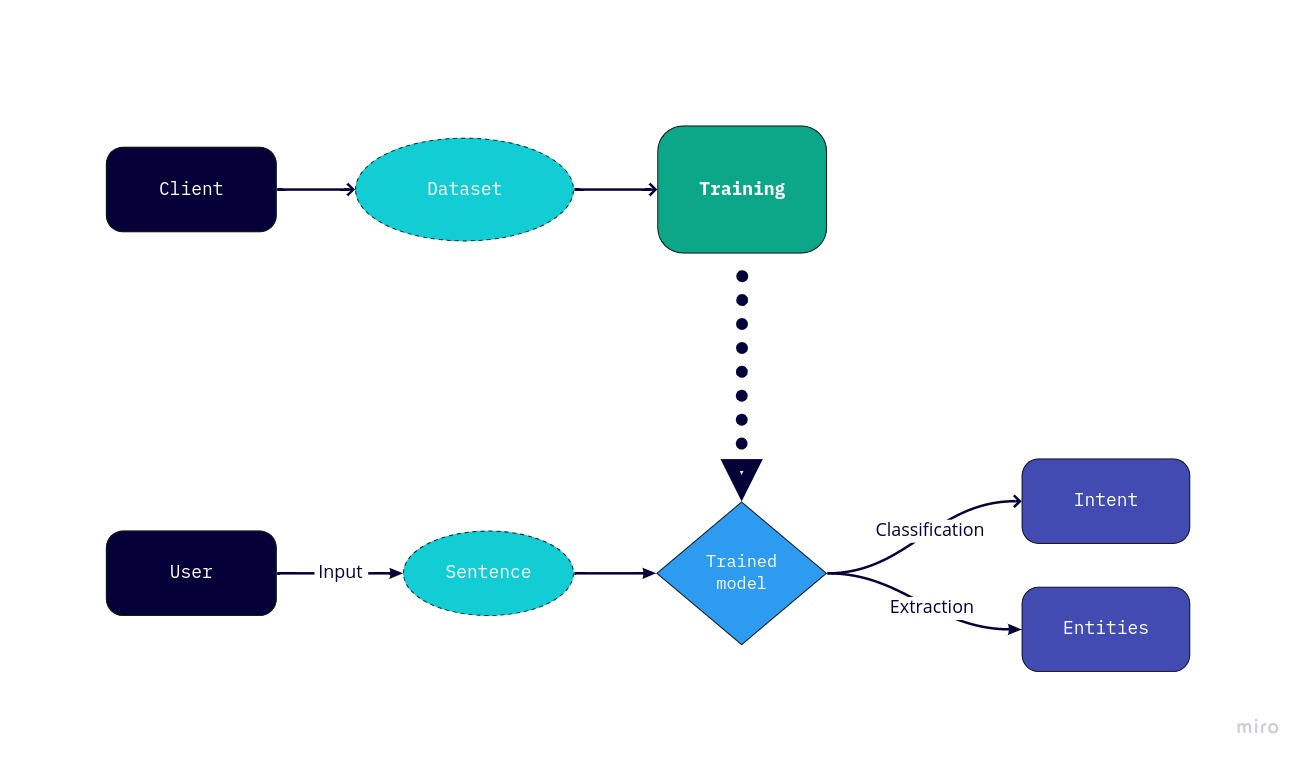Initial concepts
So, what we can do with the Platform?
How do I know if my company needs a chatbot?
Register and login
First Steps - Creating your project
Choose your plan
Profile
Permissions system
Project Dashboard
Platform's Glossary
2-Factor Authentication
Invalid authentication code
General settings
Artificial Intelligence
Zero Shot Learning
WeniGPT
What is the Weni Platform's AI Module?
Overview
What is an Intelligence?
Intents and Entities
Hands-on
Creating an Intelligence
Training your Intelligence
Intelligence Force
Tests
Inbox
Translating your dataset
Share your AI with translators
Requesting authorization
Versions
Settings
Integration
Integrate an intelligence to your project in the Weni Platform
Introducing the Content Intelligence
Integrating a Content Intelligence
Updates
Glossary
Guidelines and Good practices
Flows
Expressions and Variables Introduction
Variables Glossary
Expressions Glossary
Flows Creation
Flows introduction
Flow editor and tools
Action cards
Decision cards
Adding Media to the message
Call Webhook: Making requests to external services
Split by Intent: Using Classifiers
Import and export flows
Using expressions to capture the user's location
Viewing reports on the platform
Route markers
Studio
Contacts and Messages
Groups
Messages
Triggers and Campaigns
Adding a trigger
Triggers Types
Tell a flow to ignore triggers and keywords
Campaign introduction
How to create a Campaign
Editing events
Creating contact from an external Webhook
Contact history
How to download, extract, transform and combine archived data from Weni Flows
Channels
Settings
Channels Introduction
Adding a Facebook Channel (RapidPro)
Adding a Viber channel
How a SMS Integration Works
General API concepts and Integrations
How to create a channel on twitter
How to create a channel on Instagram
Main steps to active Whatsapp for UNICEF
Adding Discord as a channel
Creating a Slack Channel
Adding a Viber channel (RapidPro)
Creating a Microsoft Teams channel
Weni Integrations
How to use the integrations module
Adding a Web channel
Adding a Telegram channel
How to create a channel with whatsApp demo
Whatsapp: Weni Express Integration
How to create template Messages: Whatsapp
Creating a Microsoft Teams Channel
Whatsapp Business API
Integrations
Human Attendance
Weni Chats: Introduction to the Chats module
Weni Chats: Setting Up Human Attendance
Weni Chats: Human Service Dashboard
Weni Chats: Human Service Management
Weni Chats: Attendance distribution rule
Weni Chats: Using active triggering of flows
Weni Chats: CoPilot
Ticketer: Ticketer on Rapid Pro
Ticketer: How to integrate Rocket.Chat as a ticket service on the Weni Plataform
How to send message templates through RocketChat
RocketChat call routing
RCAdmin API: Agent-Activity
U-Partners - Proper use of features
Using groups to organize human attendance
Data and BI
How to Install and Use the Weni Data Connector for Power BI
Incremental Update - Power BI
Explore Weni's Database Documentation
Tips for Data Modeling in Power BI
Filter using Contact Fields in Power BI
UX Writing
- All Categories
- Artificial Intelligence
- Intents and Entities
Intents and Entities
 Updated
by Michelli Silva
Updated
by Michelli Silva
Intent classification and Entity extraction
The dataset is composed by training sentences and testing sentences. These sentences helds important components used to define your intelligence context: intents and entities.
Through this components, we have enough data to guide a rich conversation flow in a chatbot.
The intelligence usage is done through intent classifications and entity extractions:

Intentions
Intents are what define the context of your intelligence. Upon receiving a sentence to classify, your intelligence will respond to which of the trained intents that sentence is most likely to belong to.

Therefore, it is crucial to make an early planning about the intelligence scope, so the intentions can be clearly and precisely defined.
By doing a detailed early planning, an eventual need of changing the intelligence's scope, removing or adding new intentions after launch is drastically reduced.
See here how to add intentions!
Entities
They are components used to extract additional information when sending a sentence to the intelligence, in addition to its labeled intention.
In Bothub, its usage is made by defining groups of words that belong to the same category, for example, by marking separately:
- pepperoni, mozzarella, margherita as flavor
- television, smartphone, tablet as product
Your intelligence will automatically try to search for flavors and products in the received sentences, extracting them and returning as a response along with the labeled intent.
It is important to note: the intelligence will try to extract even other words that were not explicitly marked by you, but that in its understanding has a high probability of belonging to that group of words (entity).
For example, considering the product entity above, using these three markings alone, should also extract words like computer, laptop and tv as product.
See here how to use entities!
